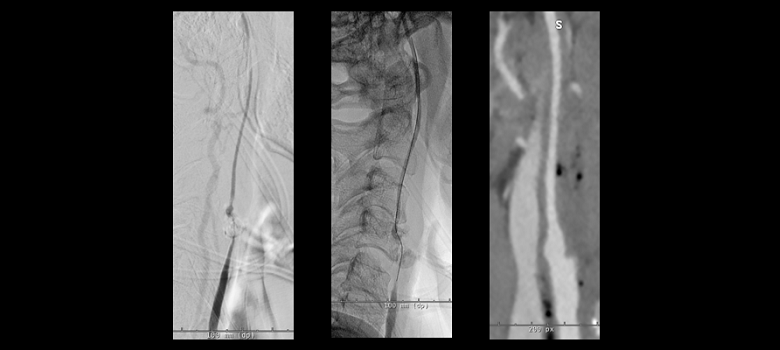Combined with proximal calcification, the ultrasound-observed pattern may represent a pathogenic picture that increases plaque migration risk.

A unique pattern of movement on the surface of carotid plaque that is visible on ultrasound may be a key indicator of which patients will experience ischemic stroke following carotid artery stenting, according to a study published online last month in the Journal of Neurosurgery.
“We previously reported that carotid ultrasonography can detect the mobile component of the carotid plaque surface, which rises and falls in a manner asynchronous with arterial pulsatile wall motion,” write the authors, led by Nobuhiko Ichinose, MD (Hiroshima University, Hiroshima, Japan).
They refer to this pattern of movement as the “jellyfish sign.”
“Our pathological findings demonstrated that fibrous cap thickness negatively correlates with ultrasonographic plaque surface movement in the jellyfish-positive portion of the plaque,” the investigators note, “suggesting that the jellyfish sign indicates thinning and rupture of the fibrous cap over the unstable plaque content, that is, the lipid-rich necrotic core or internal plaque hemorrhage.” This thinning and rupture leads to release of thrombogenic factors into the lumen, resulting in repeated ischemic stroke, they say.
Ichinose and colleagues looked at multiple risk factors, including the jellyfish sign, for the development of new ischemic lesions following carotid artery stenting among 77 patients with 86 carotid artery lesions. The presence of ischemic stroke was determined using diffusion-weighted imaging.
While several reports have linked presence of the jellyfish sign with an increased risk of ischemic stroke, this is the first to examine it specifically within the context of carotid artery stenting.
The jellyfish sign, proximal calcification, and LDL cholesterol level emerged as the most significant predictors of new DWI lesions using several different statistical models.
Plausible Mechanism Suggested
Patients who not only the jellyfish sign but also proximal calcification were at significantly increased risk of ischemic stroke following stenting. The authors suggest a mechanism by which both these factors together could increase stroke risk, explaining that stents, once deployed, expand distally to proximally, thus shifting the soft contents of the plaque in the same direction (known as the snowplow effect). This leaves the soft contents of the plaque “sandwiched” between the stent and the calcified component of the plaque, increasing the inner pressure of the plaque.
“With the calcified component at the proximal shoulder portion of the fibrous cap (that is, the thinning and weak part), soft plaque would apply higher pressure, thereby squeezing the soft content of the plaque into the lumen,” they continue.
The authors point out that all three of the important predictors—jellyfish sign, proximal calcification, and LDL cholesterol—can be easily determined in a standard clinical visit and thus could be used as practical tools for helping reduce ischemic stroke in patients with stenosis of the cervical carotid artery.
Source:
Ichinose N, Hama S, Tsuji T, et al. Predicting ischemic stroke after carotid artery stenting based on proximal calcification and the jellyfish sign. J Neurosurg. 2017;Epub ahead of print.
Disclosures:
Ichinose reports no relevant conflicts of interest.

